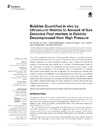Please use this identifier to cite or link to this item:
https://accedacris.ulpgc.es/jspui/handle/10553/42530
| Title: | Bubbles quantified in vivo by ultrasound relates to amount of gas detected post-mortem in rabbits decompressed from high pressure | Authors: | Bernaldo de Quiros, Yara Møllerløkken, Andreas Havnes, Marianne B. Brubakk, Alf O. González Díaz, Oscar Manuel Fernández Rodríguez, Antonio Jesús |
UNESCO Clasification: | 310907 Patología | Keywords: | Blockage of circulation Bubble grade Decompression sickness Gas bubbles Gas emboli |
Issue Date: | 2016 | Project: | Agl2005-07947/Gan Valoración Del Estado Sanitario de Cetáceos de la Familia Ziphiidae ("Zifios") en El Archipiélago Canario Patologia Embolica " Gaseosa / Grasa " en Cetaceos |
Journal: | Frontiers in Physiology | Abstract: | The pathophysiological mechanism of decompression sickness is not fully understood but there is evidence that it can be caused by intravascular and autochthonous bubbles. Doppler ultrasound at a given circulatory location is used to detect and quantify the presence of intravascular gas bubbles as an indicator of decompression stress. In this manuscript we studied the relationship between presence and quantity of gas bubbles by echosonography of the pulmonary artery of anesthetized, air-breathing New Zealand White rabbits that were compressed and decompressed. Mortality rate, presence, quantity, and distribution of gas bubbles elsewhere in the body was examined postmortem. We found a strong positive relationship between high ultrasound bubble grades in the pulmonary artery, sudden death, and high amount of intra and extra vascular gas bubbles widespread throughout the entire organism. In contrast, animals with lower bubble grades survived for 1 h after decompression until sacrificed, and showed no gas bubbles during dissection. | URI: | https://accedacris.ulpgc.es/handle/10553/42530 | ISSN: | 1664-042X | DOI: | 10.3389/fphys.2016.00310 | Source: | Frontiers in Physiology [ISSN 1664-042X], v. 7 (310) |
| Appears in Collections: | Artículos |
SCOPUSTM
Citations
4
checked on Jun 8, 2025
WEB OF SCIENCETM
Citations
6
checked on Jun 8, 2025
Page view(s)
106
checked on Jul 6, 2024
Download(s)
109
checked on Jul 6, 2024
Google ScholarTM
Check
Altmetric
Share
Export metadata
Items in accedaCRIS are protected by copyright, with all rights reserved, unless otherwise indicated.
